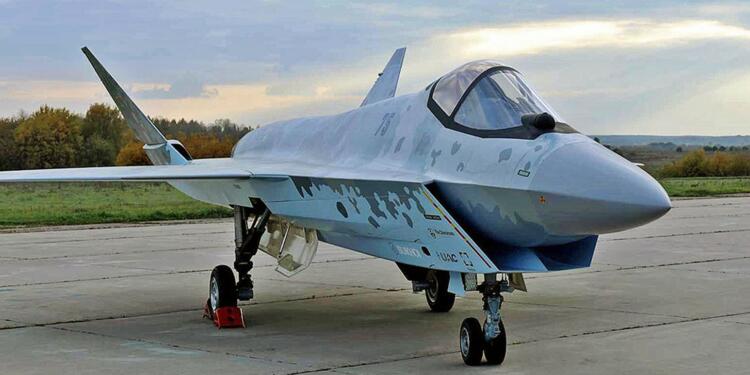India fifth-generation aircraft: If I ask about the best example of friendship between countries, you will possibly end up naming India and Russia. Undoubtedly, Russia and India share a friendly bond which breaches all the odds of the geopolitical turmoil. India and Russia have shared a friendly relation for almost 52 years now.
India considers it as the closest and most trusted ally because Russia supported India when the whole world was determined to leave India isolated. And India acknowledges that. The India Foreign Minister, Dr. S Jaishankar’s reply to a question by an Austrian TV news anchor during his visit to Austria is an example of that. When asked about India’s oil trade with war and supporting Russia. He schooled the anchor by saying that Russia helped India when the whole west decided to support a country that promotes terrorism.
The Indo-Russia Friendship Treaty of 1971 is the manifestation of that friendship. That is why, one section of geo political scholars believe that India’s stand on the ongoing Russia-Ukraine war is less neutral foreign policy and a more tacit support to its all-weather friend.
However, it is a matter of debate, still India and Russia share a strong bond that they both desperately need, especially in recent times. From time along we have heard statements from both sides that call for the praise of each other and a craving for strengthening of relations.
And now India is going to get an offer on fifth-generation aircraft manufacturing. The recent developments around fifth-generation aircraft are crucial for both the countries and needs a deeper analysis.
Russian checkmate move
From 13th to 17th of February, Defence Exhibition Organisation of Defence Ministry is organising “Aero India show”. The largest Asian air show and exhibition is to be held in Bengaluru. The delegation from all across the world join the event twice a year. And as obvious Russia too is joining the upcoming event. According to the Russian news agency TASS, the Russian delegation attending the international air show is planning to discuss the potential cooperation with India.
The cooperation will be sought to create fifth-generation aircraft. According to TASS source from Rostec, “A delegation of representatives of our aircraft-building companies will attend the Aero India air show. We plan to discuss cooperation in fifth-generation aircraft. In particular, there is the intention to invite our Indian partners to join the Checkmate light tactical fighter project.”
It is interesting to know that in the show of 2021, Russia featured over 200 military products, thereby making it an active partner of the event.
The checkmate fighter is the derivative of Su-57 Felon, a fifth-generation aircraft. It is a Light Tactical Aircraft (LTA). Also, known as Su-75 ‘Checkmate’, the fighter jet is 46 feet long with 39 feet wingspan. Checkmate is a single engine aircraft that was first showcased in MAKS air show near Moscow in 2021. Later in Dubai air show, it was showcased for the first time in foreign land. Checkmate is expected to take its maiden flight in 2023, while the serial production will start from 2026. The aircraft is lighter and cheaper than other modern combat jets like F-35 Lightning II of United States of America.
The aircraft has a 7,400kg armament carrying capacity, a speed of 2,200 km/h (1,367 mph), and a 2,800 kilometres (1,740 miles) range. Although the range is a little less than previously stated, it is still impressive and will be accomplished using external fuel loads.
As far as its capabilities are concerned it will have a maximum speed of Mach 1.8, which means, the jet has the maximum speed of 1.8 times the speed of sound. While former Su-57 led to the debacle for Russia in competing with foreign market, checkmate is an approach to gather appraisal from the world. Probably, that is why Russia is looking towards India. But, let us understand the whole game of the aircrafts production and its competition.
Fifth-generation aircraft and India
Fifth generation aircrafts are fighter jets inbuilt with the technology of 21st century. The first aircraft of such a generation was introduced by United States, the F-22 Raptor, which entered service in 2005. The characteristics of a fifth-generation fighter are not universally agreed upon and not every fifth-generation type necessarily has them all.
However, they typically include stealth, low-probability-of-intercept radar (LPIR), agile airframes with super cruise performance, advanced avionics features and highly integrated computer systems capable of networking with other elements within the battlespace for situation awareness and C3 (command, control and communications) capabilities.
There are only 16 fifth generation aircrafts among which some are still under manufacturing process. The major countries that are in the competition of supremacy in fifth generation fighter jets are United States, China, Russia, Turkiye, South Korea and India. India is working to produce its first fifth gen fighter jet AMCA by 2030. AMCA is being manufactured under the joint venture of India and Russia.
If we look at the fifth-generation aircrafts of Russia, the first one was Su-57. India and Russia started a JV to manufacture FGFA based on Su-57. But in 2018, India withdrew from the deal. According to India, it was expensive, poorly engineered and powered by old and unreliable engines. While cancelling the deal India assured to accept it when Su-57 joins the Russian Air Force.
Now, Su-75 checkmate is a new derivative of Su-57 and is considered by many defence experts as one of the best aircrafts in the world. So, Russia is actually looking to carry on the previous deal with a new fighter jet.
Read more: Reason why India will reject Biden’s offer to co-develop AMCA engines
The Indian angles of the story
There are many angles to the story.
First, India is continuously working in the direction of self-reliance. The Atmanirbhar Bharat and Make In India initiatives are proving to be successful. India is not only manufacturing but also exporting indigenous defence equipment. India has recently joined the club of nations with aircraft carrier manufacturing capability. India had also been successful in manufacturing a complete indigenous aircraft called Tejas. Just recently, Asia’s biggest helicopter facility was inaugurated by Prime Minister Modi.
Secondly, indigenous manufacturing will reduce imports and Russia, since long has been a major supplier of arms and ammunitions to India. There was a time when it stood to almost 74 %. Now it has reduced to 35% as of 2020. Since then, imports have only reduced.
The third is that, in the ongoing war, India stands neutral. But somehow, India believes that Russia is in between a crisis that will eventually escalate once the war is over. So, remaining dependent on Russia blindly is not going to work. But, as India could not join USA after reducing the dependencies on Russia, India needed a reliable partner that is not inclined towards USA. And France is one such country. So, India increased its bilateral dealings with France and as a result the defence trade along with others is soaring.
Also read: The growth story of India’s defence manufacturing under PM Modi
Why India can take this deal?
On the part of Russia, all the three angles are posing a threat to its relationship with India. Although, India does not want to compromise the relations with Russia that is why, it is not jumping directly towards United States. Despite all this, India can accept the offer of Russia when it comes to checkmate simply for the following reasons:
Checkmate is anticipated as the best fifth-generation aircraft with immense capabilities. It gives an opportunity to attack the objective without entering the adversary’s space.
India has the bargaining chip when it comes to checkmate because of the failed Su-57. Russia’s pre-emptive call is a signal of Russia’s approval to it.
However, the landing and take-off of LCA Tejas has been tested successfully on INS Vikrant. Indian Navy is looking to procure foreign aircraft for INS Vikrant and INS Vikramaditya. France and USA are the top contenders for it. Now, with Checkmate, India gets another contender in the form of Russia.
This can also be another deal to hold the friendly relations apart from oil trade. As, despite a tremendous hike in oil trade, China and Turkeye have become the biggest trading partners of Russia. Russia’s increasing dependency on China is actually a threat to India. In today’s Asia, the competition of domination is between India and China. Moreover, being one the of biggest markets and manufacturers, who wins Asia will prove to be the greatest power of the world. And, China being aware of Russia’s economic fragility is eyeing to make Russia dependent on itself and thereby using i’s military strength.
If India takes the deal and manufactures the Checkmate in India with the full capacity, it may turn out to be the biggest manufacturer of Fifth Generation Aircrafts. And since Fifth gen aircrafts are not easily available for all the countries, India can negotiate the clause of trading it with other countries like Bangladesh among others. Manufacturing in India will also increase the credibility of the aircraft and hence, it may get interest from other countries as well.
Apart from all other reasons, the aircraft is expected to be the most affordable fifth generation aircraft in the global arms market.
Russian limitations with Checkmate
If we look at some of the limitations of Russia, we find that the sanctions imposed on Russia because of the war in Ukraine has made it difficult for Russia to procure critical technology required to produce large volumes of its sophisticated combat sensors with microprocessor subsystems.
Developers are facing financial issues. They are actively looking for a foreign partner to fund this program. And obviously, India is one of those partners as India’s economic growth has been tremendous in the recent years. Russia needs to boost its defence sector that is witnessing a decline after the commencement of the war.
What should India do?
In order to understand the anticipated move of India, let us sum up the details. Firstly, India has an edge in this project because of geo-political turmoil and relationship between the countries. Secondly, the aircraft is effective and affordable and comes with immense possibilities for India. Thirdly, India does not want to lose Russia as it’ partner and with the recent trends, India is unwillingly pushing itself towards the west.
So, if we look towards the current situations, it is most likely that India will conclude the deal in the near future. As, geopolitical tensions of the world are secondary for India. The nation prioritizes its own security and “Checkmate” may prove to be an advancement in its military capability in the subcontinent. Adding to that, since the developers are seeking foreign investment, the reluctance of India can lead them to sit in the lap of China which will be a bigger threat for India.
Support TFI:
Support us to strengthen the ‘Right’ ideology of cultural nationalism by purchasing the best quality garments from TFI-STORE.COM































